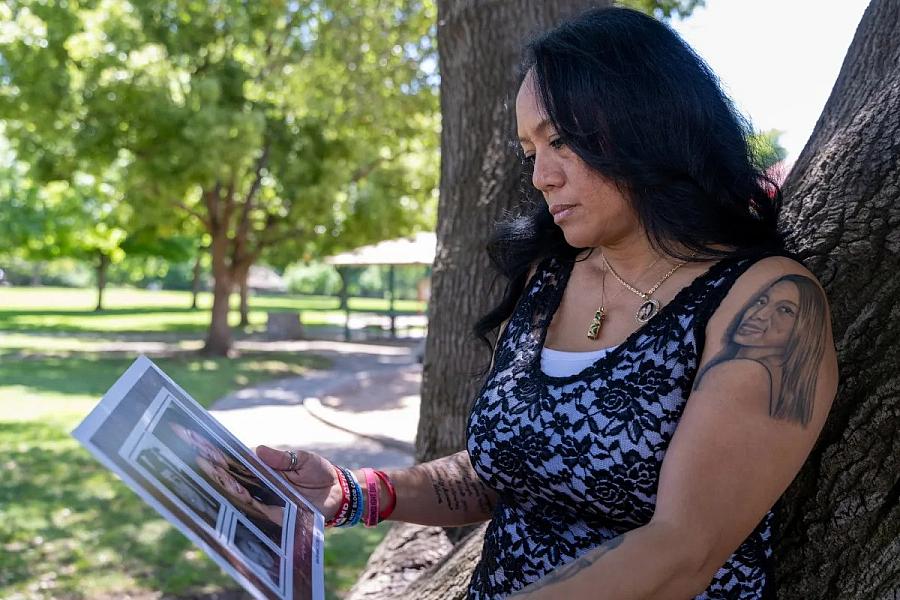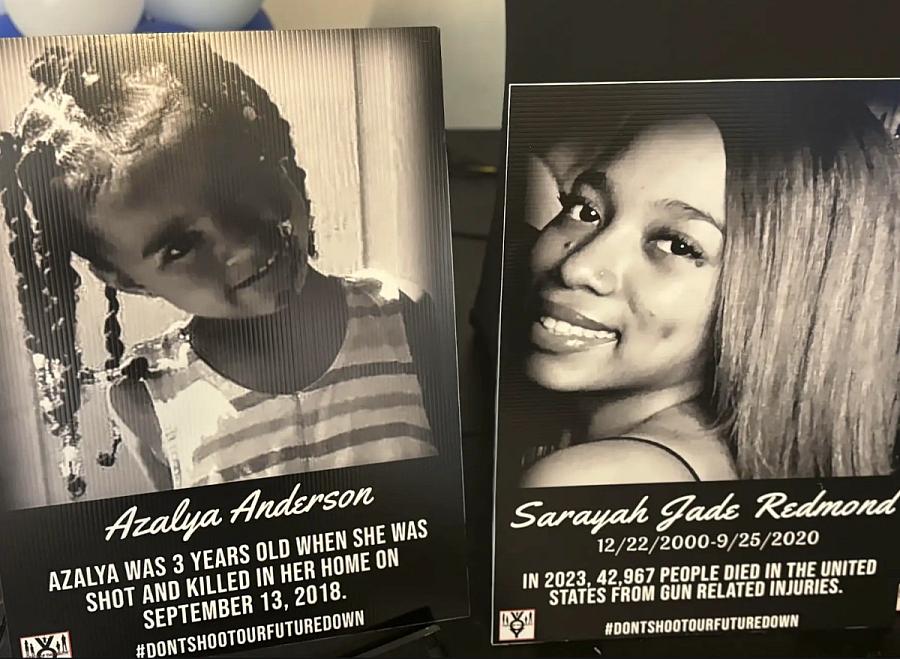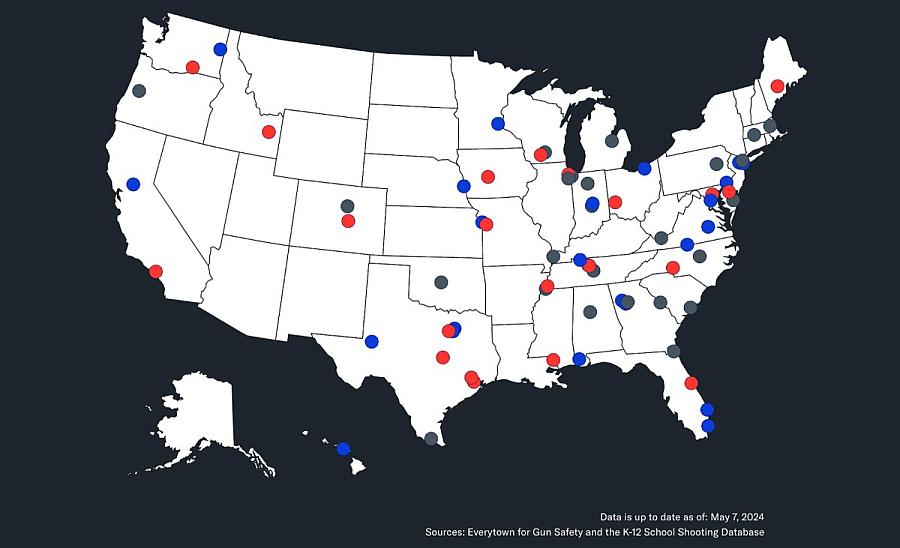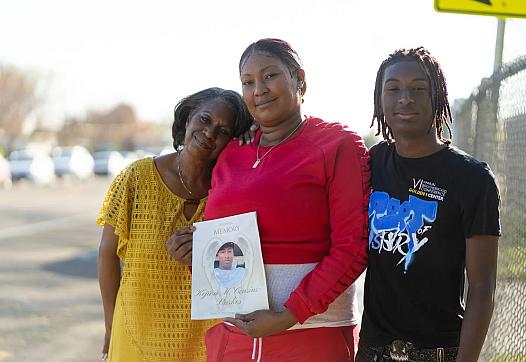Targets, From Toddlers To Teens
The story was originally published in The Observer with support from our 2024 California Health Equity Impact Fund.

Paula Anderson lost her 3-year-old daughter Azalya to gun violence in 2018.
Russell Stiger II, OBSERVER
Paula Anderson was getting her young children ready for bed, looking at pictures with her 3-year-old daughter Azalya in her home near Power Inn Road in 2018 when gunshots rang out.
She grabbed her daughter, but as they ducked, a bullet whizzed by Paula and struck Azalya in the back of the head.
Azalya was one of 62 victims aged 19 or younger who were killed by gunfire in Sacramento County between 2018 and 2023, according to an OBSERVER analysis of coroner’s office data.
Thirty-four of those victims, or 55%, were Black people, who make up about 11% of the county population.
“I knew she was shot,” Anderson, 42, tells The OBSERVER.
She says shootings are commonplace in her neighborhood: “In South Sac, if you hear gunshots, you better get down. I’ve lived here for a long time and there have been shootings and shootings and shootings. Bullets fly and hit houses.”
“I was covered in blood and had bits of my baby’s brain in my mouth from trying to stop the blood,” Anderson says. “Some days I wake up and I’m in tears. There are some days I can’t get out of bed. This nightmare is my reality.” She has trouble sleeping and when she does she has night terrors.
“I wake up scared in the middle of the night and panting hard, not knowing where I’m at,” Anderson says. “I’m having to remind myself where I am at and I’m feeling like this because my 3-year-old daughter is dead and she’s never coming back.”
She says that after her daughter was killed she became homeless for three years. She couldn’t go back into the house that her daughter was killed in.
“To this day there never has been any normalcy,” Anderson says.

Jennifer Redmond’s 19-year-old daughter Sarayah was shot and killed in 2020.
Russell Stiger II, OBSERVER
Anderson says many things went wrong with her case.
Police said a witness outside the home was uncooperative. They arrested three men for the crime.
Christopher Richi-Bibbs, one of the three men arrested, agreed to a plea of involuntary manslaughter in 2022, more than two years after Azalya’s murder. Anderson says the plea agreement followed threats to witnesses who then refused to testify. The “rule in the streets” is to not talk to the police. Those who do are labeled “snitch.”
Superior Court Judge Maryann Gilliard recalled how days of testimony resulted in witnesses initially invoking their Fifth Amendment rights, refusing to incriminate themselves. Gilliard said immunity was offered but even then, some witnesses had gaps in memory from previous testimony while others had conflicting stories.
“There are gangs out here and people don’t want to get involved because people’s lives are being threatened,” Anderson says. “Nobody wanted to testify on anything.”
Richi-Bibbs, 25, was sentenced to 26 years in state prison.
The other two men who were arrested in connection with Azalya’s murder were let go because of lack of evidence and witnesses being unwilling to testify.
Lost Ones

Azalya Anderson, left, and Sarayah Redmond both were killed by bullets unintended for them.
Robert J. Hansen, OBSERVER.
Sarayah Jade Redmond, 19, was at a friend’s house in South Natomas watching a movie when shots were fired into the apartment in 2020.
“She was in the wrong place at the wrong time,” says Sarayah’s mother Jennifer Redmond, 55.
Jennifer Redmond was attending her cousin’s funeral in Las Vegas when she got the call that her daughter had been shot.
“I didn’t even walk into his funeral service because I had to get on an airplane and come back,” Redmond says.
Two years after Sarayah was killed, Sacramento police issued an arrest warrant for 20-year-old Treace Palmer, who was already in custody on unrelated charges in Washoe County, Nevada.
Palmer was 18 when he allegedly shot and killed Sarayah.
Sarayah’s eyes would draw you in and her smile would make you smile, says Redmond, who also recalls her daughter’s infectious laugh.
“She was our ray of sunshine,” Redmond says. “We used to call Sarayah the baby whisperer because she could make any baby calm down.”
Redmond says she lived a sheltered life as a military child and wasn’t impacted by gun violence “until it was my daughter.”
Nicole Clavo, director of Sacramento’s Office of Violence Prevention, which is part of a national network of such offices, lost her son J.J. Clavo in 2015 to gun violence. She says deciding to be a survivor or a lifelong victim of gun violence is a choice. “As a parent, you have to decide on whether or not you want to live through the trauma or you want to succumb to it.”
J.J.’s killer, Keymontae Lindsey, was released from prison last year after serving just eight years because he was 15 at the time of the crime. Senate Bill 1391, which took effect in January 2019 while Lindsey’s case was underway, prevents prosecution of those age 16 and younger in adult court, even for murder.
Under the old law, Lindsey could have been sentenced to 87 years to life.
J.J.’s murder crushed his family and community, Clavo says. Her parents lost a grandson, his sister lost a brother and people he knew lost a friend.
“We lost a young man who may have been even greater than even what I thought he was,” she says. “I’ll never know what being a grandmother is to his children. I’ll never know whether he went into the military or graduated from college, or any of the things that parents look forward to.”
J.J. was a student at Grant Union High School – the teachers who tried to save his life and the other students who knew him all were impacted, Clavo says. “It is a memory that they will forever live with.”
The school earlier this month suffered the loss of another student who was set to graduate when 18-year-old Jeremiah Walker was shot and killed at a house party in Natomas.
Walker was gunned down at a house on the 3100 block of Buchman Street in Natomas. Police say an investigation is ongoing.
Mervin Brookins, founder of Brother to Brother Mentoring, considers himself Walker’s grandfather after helping raise him. According to Brookins, a parent had rented the home as a short-term rental for a party on Saturday, with no adult supervision. A fight broke out at some point and shots were fired, one of which struck Walker, who was not the intended target.
He says there’s no pain like losing a child or loved one.
“There’s nothing that compares to it and there’s nothing you can do about it.”
How Kids Get Guns

Sacramento County gun violence fatalities aged 19 years or younger from 2018 to 2023.
Sacramento County Coroner data, Graphic by Robert J. Hansen, OBSERVER
Last year another 18-year-old Grant student, Billy Ray Scott, was shot and killed a day before graduation. Scott was sitting inside a vehicle with two other people in a North Highlands neighborhood when someone approached the vehicle and fired through the passenger side, hitting Scott.
In January, a 14-year-old student was arrested at Grant High School after shooting another 17-year-old student.
The school was on lockdown most of the day after the on-campus shooting. The victim survived.
Students had to barricade their doors in response to the shooting, including Leah Nelson, Grant High’s student president, who spoke to the OBSERVER days after the shooting. “I think that when you hear the words lockdown, your heart immediately goes racing and your mind goes all the wrong places,” she said then.
The Black Child Legacy Campaign, in partnership with Roberts Family Development Center, addresses the high volume of Black child death and violence, program manager Bryant Wyatt says.
Wyatt says shootings at Grant High are uncommon, but school shootings are increasing around the country. In 2024 there already have been at least 72 incidents of gunfire on school grounds, resulting in 27 deaths and 43 injuries nationally, according to Everytown Research.
The January shooting at Grant High is one of two in California this year. The other happened at Ellen Ochoa Learning Center in Los Angeles where a teen was shot and killed and another was wounded.
In 2022, a second-grader brought a gun and a loaded magazine to Edward Kemble Elementary School in the Meadowview neighborhood, according to Sacramento City Unified School District officials.
Two mentees with Voice of the Youth, which provides training and mentorship to children and families through interactive group discussions and age-appropriate activities and whose names are undisclosed for safety concerns, say that it seems like “everyone” in high school has guns.
The first mentee, who attended Inderkum High School, says that for about $500, anybody can go to platforms such as eBay or Telegram and buy the parts to easily assemble a gun.
“They’re not hard to get,” he says.
“There are videos on YouTube that show you how to make them,” the mentee says. “It’s not hard.”
In August 2022, the Biden administration issued a rule, implemented by the Bureau of Alcohol, Tobacco, Firearms and Explosives, to prevent the spread of ghost guns by clarifying that all ghost gun kits and some parts are required to be serialized, sold by a licensed dealer, and are subject to a background check.
After a group of gun owners, advocacy groups and ghost gun distributors filed a lawsuit against ATF in August 2022, a federal district court in Texas invalidated the entire regulation, including those that were not at issue in the lawsuit.
The Supreme Court last month agreed to review a lower court decision that invalidated the rule. The case will be argued in the court’s next session, which begins in October.
The Social Media Effect

Gunfire on school grounds in the United States. In 2024 there have been at least 78 incidents of gunfire on school grounds, resulting in 27 deaths and 47 injuries nationally.
The second Voice of the Youth mentee, who went to Florin and William Daylor high schools, says students buy guns to be popular and post themselves posing with guns on TikTok and Instagram.
“The more stuff you do [have guns or sell drugs] the more popular you get,” she says.
Now that active shooter drills have become commonplace in schools, she says it makes her realize how gun violence is an everyday part of life.
“These drills made me realize that I could die at any moment and at the same time it desensitized me from that danger from seeing it everywhere [on social media],” she says.
Berry Accius, founder of Voice of the Youth, says every student he talks to says COVID changed the culture in schools, from the number of guns students have to the use of social media and their activities outside of school.
He says if parents monitor their children’s social media accounts, they could see in real-time how they are behaving.
“Parents are either blind, oblivious, [or] in denial and want to pretend their babies are still babies when there are so many kids that have inherited this mentality of being a demon,” Accius says.
Accius says violence has become normalized, particularly with younger people.
“It’s cool to be bad, it’s cool to have guns,” Accius says. “The problem is now that they are younger and younger.”


